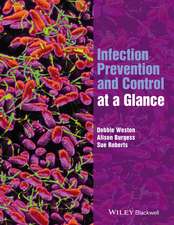Beyond Anthrax: The Weaponization of Infectious Diseases
Editat de Larry I. Lutwick, Suzanne M. Lutwicken Limba Engleză Hardback – 23 oct 2008
This book presents the history of the topics and clinically relevant discussions on those high risk (Category A) diseases beyond anthrax as well as a number of infections and toxins at the Category B level. Importantly, in addition, the text includes sections on Public Health Infrastructure, Public Health Law, Surveillance, Mental Health Management and Media Role all of which relate to epidemics of any sort, not just intentional biological events.
Beyond Anthrax: The Weaponization of Infectious Diseases is a product that should serve as a reference point for clinicians, epidemiologists and public health personnel to understand in practical detail many of the aspects of weapons of biowarfare as well as the appropriate responses to them.
Preț: 1104.84 lei
Preț vechi: 1162.99 lei
-5% Nou
Puncte Express: 1657
Preț estimativ în valută:
211.44€ • 229.59$ • 177.61£
211.44€ • 229.59$ • 177.61£
Carte tipărită la comandă
Livrare economică 22 aprilie-06 mai
Preluare comenzi: 021 569.72.76
Specificații
ISBN-13: 9781588294388
ISBN-10: 1588294382
Pagini: 392
Ilustrații: XVI, 374 p. 6 illus.
Dimensiuni: 155 x 235 x 25 mm
Greutate: 0.68 kg
Ediția:2009
Editura: Humana Press Inc.
Colecția Humana
Locul publicării:Totowa, NJ, United States
ISBN-10: 1588294382
Pagini: 392
Ilustrații: XVI, 374 p. 6 illus.
Dimensiuni: 155 x 235 x 25 mm
Greutate: 0.68 kg
Ediția:2009
Editura: Humana Press Inc.
Colecția Humana
Locul publicării:Totowa, NJ, United States
Public țintă
ResearchCuprins
The History of Bioterrorism: Old Idea, New Word, Continuing Taboo.- Smallpox and Bioterrorism.- Plague.- Tularemia.- Botulism.- The Viral Hemorrhagic Fevers.- Melioidosis.- Epidemic Typhus Fever.- Category B Biotoxins.- Intentional Terrorist Contamination of Food and Water.- Public Health Infrastructure.- Public Health Law and Biological Terrorism.- Public Health Surveillance for Bioterrorism.- Psychosocial Management of Bioterrorism Events.- The Role of the Media in Bioterrorism.- Rapid Detection of Bioterrorism Pathogens.- Plant Pathogens as Biological Weapons Against Agriculture.
Recenzii
From the reviews:
10 November 2008
New Biodefense Book Includes Media, Legal, and Psychosocial Perspectives as well as Pathogens
Last month a valuable new 17-chapter book on biodefense issues was published titled Beyond Anthrax: The Weaponization of Infectious Diseases. The editors are Dr. Larry Lutwick and Suzanne Lutwick and the publisher is Springer/Humana Press. Updated chapters devoted to many of the CDC Category A and B threat agents are followed by excellent chapters on media, legal, psychosocial, and public health infrastructure perspectives.
For example, a chapter titled The Role of the Media in Bioterrorism by David Brown, a Science writer for the Washington Post, provides a detailed analysis using specific issues and quotations from the 2001 anthrax letter attacks. He begins by discussing two concepts: (1) the principle of parsimony (e.g., Occam's razor) and (2) the bell-shaped curve. The Principle of Parsimony he defines first. One should always choose the simplest explanation of a phenomenon, the one that requires the fewest leaps of logic and the principle that entities should not be multiplied needlessly; the simplest of two competing theories is to be preferred.
Brown observes that Bioterrorism dilutes the importance of parsimony. That's because bioterrorism is an unnatural event even if its components---viruses, toxins, organs, medicines---are each natural and at some level behaving in familiar ways. Bioterrorism creates interactions that do not occur on their own. It produces conditions of unpredictable risk; it makes vulnerable people who aren't normally vulnerable.
He also describes the bell-shaped curve and notes that bioterrorism tends to magnify the importance of the bell curve as an informative idea. The bell-shaped curve depicts that: Most outcomes are similar to one another. They inhabit the fat, or humped-up, part of the curve, and define the average. A small number, however, are quite different from the rest, either much less or much more by whatever metric is in use. Those outcomes inhabit the two thin ends, or tails, of the curve. Such a bell-shaped curve could be applied to help explain how several persons may have been infected by the Bacillus anthracis bacteria sent through the mail system in 2001.
Brown's discussions are especially interesting when he describes US Anthrax Attacks---The Media and HHS, US Anthrax Attacks---The Media and the CDC, and Getting It Right.
Daniel R. Lucey, MD, MPH
EROne Institutes, Washington Hospital Center
Ajunct professor of Microbiology and Immunology
Georgetown University Medical Center
Washington, D.C.
Website for this posting: www.BePast.org
e-mail:DRL23@Georgtetown.edu
"This book attempts to deal with the broad topic of biological weapons. … The intended audience is quite broad. The authors mention clinicians and epidemiologists, who are an appropriate audience, but those involved in public safety and policy should also be interested. … In all, I enjoyed the book." (Peter Katona, Doody’s Review Service, February, 2009)
“Although there have been scores of publications on anthrax since 2001, relatively few have been written on other microbes of concern. Beyond anthrax … seeks to address this gap. … All in all, Beyond Anthrax, which is intended to be a ‘primer for clinicians and epidemiologists on a variety of agents, organisms, or toxins…of potential use in a biologically attack…,’ provides much more in its 17 chapters and 374 pages. … offers a thoughtful review of germs not-to-be-forgotten and why they matter.” (Mary E. Wright, Clinical Infectious Diseases, Vol. 49, November, 2009)
10 November 2008
New Biodefense Book Includes Media, Legal, and Psychosocial Perspectives as well as Pathogens
Last month a valuable new 17-chapter book on biodefense issues was published titled Beyond Anthrax: The Weaponization of Infectious Diseases. The editors are Dr. Larry Lutwick and Suzanne Lutwick and the publisher is Springer/Humana Press. Updated chapters devoted to many of the CDC Category A and B threat agents are followed by excellent chapters on media, legal, psychosocial, and public health infrastructure perspectives.
For example, a chapter titled The Role of the Media in Bioterrorism by David Brown, a Science writer for the Washington Post, provides a detailed analysis using specific issues and quotations from the 2001 anthrax letter attacks. He begins by discussing two concepts: (1) the principle of parsimony (e.g., Occam's razor) and (2) the bell-shaped curve. The Principle of Parsimony he defines first. One should always choose the simplest explanation of a phenomenon, the one that requires the fewest leaps of logic and the principle that entities should not be multiplied needlessly; the simplest of two competing theories is to be preferred.
Brown observes that Bioterrorism dilutes the importance of parsimony. That's because bioterrorism is an unnatural event even if its components---viruses, toxins, organs, medicines---are each natural and at some level behaving in familiar ways. Bioterrorism creates interactions that do not occur on their own. It produces conditions of unpredictable risk; it makes vulnerable people who aren't normally vulnerable.
He also describes the bell-shaped curve and notes that bioterrorism tends to magnify the importance of the bell curve as an informative idea. The bell-shaped curve depicts that: Most outcomes are similar to one another. They inhabit the fat, or humped-up, part of the curve, and define the average. A small number, however, are quite different from the rest, either much less or much more by whatever metric is in use. Those outcomes inhabit the two thin ends, or tails, of the curve. Such a bell-shaped curve could be applied to help explain how several persons may have been infected by the Bacillus anthracis bacteria sent through the mail system in 2001.
Brown's discussions are especially interesting when he describes US Anthrax Attacks---The Media and HHS, US Anthrax Attacks---The Media and the CDC, and Getting It Right.
Daniel R. Lucey, MD, MPH
EROne Institutes, Washington Hospital Center
Ajunct professor of Microbiology and Immunology
Georgetown University Medical Center
Washington, D.C.
Website for this posting: www.BePast.org
e-mail:DRL23@Georgtetown.edu
"This book attempts to deal with the broad topic of biological weapons. … The intended audience is quite broad. The authors mention clinicians and epidemiologists, who are an appropriate audience, but those involved in public safety and policy should also be interested. … In all, I enjoyed the book." (Peter Katona, Doody’s Review Service, February, 2009)
“Although there have been scores of publications on anthrax since 2001, relatively few have been written on other microbes of concern. Beyond anthrax … seeks to address this gap. … All in all, Beyond Anthrax, which is intended to be a ‘primer for clinicians and epidemiologists on a variety of agents, organisms, or toxins…of potential use in a biologically attack…,’ provides much more in its 17 chapters and 374 pages. … offers a thoughtful review of germs not-to-be-forgotten and why they matter.” (Mary E. Wright, Clinical Infectious Diseases, Vol. 49, November, 2009)
Notă biografică
Larry I. Lutwick, MD is Director of the Infectious Disease Unit at the Brooklyn Campus of the Veterans Affairs New York Harbor Health Care System in Brooklyn, New York and Professor of Medicine at the State University of New York, Downstate Medical Center.
Suzanne M. Lutwick, MPH is Director of Grant Development for the Hackensack University Medical Center Foundation in Hackensack, New Jersey and adjunct faculty at State University of New York, Downstate Medical Center and at Seton Hall University, East Orange, New Jersey.
Suzanne M. Lutwick, MPH is Director of Grant Development for the Hackensack University Medical Center Foundation in Hackensack, New Jersey and adjunct faculty at State University of New York, Downstate Medical Center and at Seton Hall University, East Orange, New Jersey.
Textul de pe ultima copertă
Biological warfare has, unfortunately, in the post 9/11 world become a significant topic of discussion in both the medical and lay presses. In the wake of the biological "letter bombs" containing anthrax spores, the possibility of biologic and/or toxic attacks on civilians in any part of the world became no longer a possibility. It is now part of common discussion and consciousness.
This book presents the history of the topics and clinically relevant discussions on those high risk (Category A) diseases beyond anthrax as well as a number of infections and toxins at the Category B level. Importantly, in addition, the text includes sections on Public Health Infrastructure, Public Health Law, Surveillance, Mental Health Management and Media Role all of which relate to epidemics of any sort, not just intentional biological events.
Beyond Anthrax: The Weaponization of Infectious Diseases is a product that should serve as a reference point for clinicians, epidemiologists and public health personnel to understand in practical detail many of the aspects of weapons of biowarfare as well as the appropriate responses to them. It will be an invaluable information source for all those with an interest in biological warfare, including those who require a detailed, organized primer on the diseases thought to be those on the forefront of risk.
Larry I. Lutwick, MD is Director of the Infectious Disease Unit at the Brooklyn Campus of the Veterans Affairs New York Harbor Health Care System in Brooklyn, New York and Professor of Medicine at the State University of New York, Downstate Medical Center.
Suzanne M. Lutwick, MPH is Director of Grant Development for the Hackensack University Medical Center Foundation in Hackensack, New Jersey and adjunct faculty at State University of New York, Downstate Medical Center and at Seton Hall University, East Orange, New Jersey.
This book presents the history of the topics and clinically relevant discussions on those high risk (Category A) diseases beyond anthrax as well as a number of infections and toxins at the Category B level. Importantly, in addition, the text includes sections on Public Health Infrastructure, Public Health Law, Surveillance, Mental Health Management and Media Role all of which relate to epidemics of any sort, not just intentional biological events.
Beyond Anthrax: The Weaponization of Infectious Diseases is a product that should serve as a reference point for clinicians, epidemiologists and public health personnel to understand in practical detail many of the aspects of weapons of biowarfare as well as the appropriate responses to them. It will be an invaluable information source for all those with an interest in biological warfare, including those who require a detailed, organized primer on the diseases thought to be those on the forefront of risk.
Larry I. Lutwick, MD is Director of the Infectious Disease Unit at the Brooklyn Campus of the Veterans Affairs New York Harbor Health Care System in Brooklyn, New York and Professor of Medicine at the State University of New York, Downstate Medical Center.
Suzanne M. Lutwick, MPH is Director of Grant Development for the Hackensack University Medical Center Foundation in Hackensack, New Jersey and adjunct faculty at State University of New York, Downstate Medical Center and at Seton Hall University, East Orange, New Jersey.
Caracteristici
Most updated book to cover the gamut of potential biological threats related to biowarfare/bioterrorism Also covers significant issues related to classical and new epidemics Various aspects of the public health response to infections in both pre-event and post-event situations are also covered Includes supplementary material: sn.pub/extras













